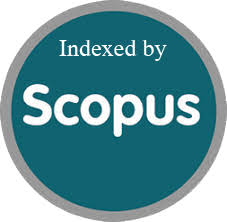Assessment of Microplastic Particles in Tap Water on The Right Side of Mosul City, Iraq
Abstract
In recent years, microplastics (MPs) contamination has become a serious concern in water distribution systems. Few studies on microplastics' numbers and their characteristics have been described. The current study focused on the abundance, characteristics, and polymer type of plastic particles in the tap water within 16 sites on the right side of Al-Mosul city, including eight areas equipped by the Alayman aljadid drinking water treatment plant (AYJ-DWTP) and eight others that supplied by water from the Alayman alqadim plant (AYQ-DWTP). A stereomicroscope (SM) is used to detect MPs abundance and morphology by capturing images of plastic particles. Fourier transform infrared spectroscopy (FTIR) was applied to distinguish polymer types. In this study, results elucidated that the presence of microplastics in the tap water of both the AYJ-water distribution network (WDN) and AYG-WDN ranged from 28 to 69 MPs/L, with an average of 45 10 MPs/L. Fibres and fragments were the dominant form of microplastics, estimated for (89-91%) of total particles. The transparent colour of particles was the most abundant. Polyvinylchloride (PVC) and Nylon Polyamide (PA) were the most common polymers of MPs around (39%) and (21%), respectively. Statistical analysis was applied by ANOVA test. The PVC risk index was very high.
References
- . Zhang et al., Microplastics in the environment: A review of analytical methods, distribution, and biological effects, TrAC - Trends Anal. Chem., vol. 111, pp. 6272, 2019, doi: 10.1016/j.trac.2018.12.002.
- A. A. Koelmans, N. H. Mohamed Nor, E. Hermsen, M. Kooi, S. M. Mintenig, and J. De France, Microplastics in freshwaters and drinking water: Critical review and assessment of data quality., Water Res., vol. 155, pp. 410422, May 2019, doi: 10.1016/j.watres.2019.02.054.
- A. J. Whelton and T. Nguyen, Contaminant Migration From Polymeric Pipes Used in Buried Potable Water Distribution Systems: A Review, Crit. Rev. Environ. Sci. Technol., vol. 43, no. 7, pp. 679751, 2013, doi: 10.1080/10643389.2011.627005.
- A.-A. AL-Dabag, Effect of Recirculation Ratio, Organic Loading and Suspended Solids Loading on the Efficiency of the Trickling Filters With Plastic Media, Al-Rafidain Eng., vol. 22, pp. 147157, 2013.
- C. Campanale, C. Massarelli, I. Savino, V. Locaputo, and V. F. Uricchio, A detailed review study on potential effects of microplastics and additives of concern on human health, Int. J. Environ. Res. Public Health, vol. 17, no. 4, 2020, doi: 10.3390/ijerph17041212.
- C. Sanz-lzaro et al., Microplastics in sediments of the Pantanal Wetlands , Brazil, no. October, 2022, doi: 10.3389/fenvs.2022.1017480.
- C. Wang et al., Microplastic Pollution in the Soil Environment: Characteristics, Influencing Factors, and Risks, Sustain., vol. 14, no. 20, pp. 114, 2022, doi: 10.3390/su142013405.
- D. Eerkes-Medrano, R. C. Thompson, and D. C. Aldridge, Microplastics in freshwater systems: A review of the emerging threats, identification of knowledge gaps and prioritisation of research needs, Water Res., vol. 75, pp. 6382, 2015, doi: https://doi.org/10.1016/j.watres.2015.02.012.
- D. Kossay K. Al-Ahmady and Z. A. Znad, The Optimum Conditions For Fluoride Removal From Drinking Water Using Nalgonda Method (Flocculation And Sedimentation), AL-Rafdain Eng. J., vol. 22, no. 2, pp. 3847, 2014, doi: 10.33899/rengj.2014.87315.
- D. Lithner, A. Larsson, and G. Dave, Environmental and health hazard ranking and assessment of plastic polymers based on chemical composition, Sci. Total Environ., vol. 409, no. 18, pp. 33093324, 2011, doi: 10.1016/j.scitotenv.2011.04.038.
- D. N. Michlerkozma, L. Kruckenfellner, A. Heitkamp, K. P. Ebke, and F. Gabel, Uptake and Transfer of Polyamide Microplastics in a Freshwater Mesocosm Study, Water (Switzerland), vol. 14, no. 6, pp. 110, 2022, doi: 10.3390/w14060887.
- F. Liu, K. B. Olesen, A. R. Borregaard, and J. Vollertsen, Microplastics in urban and highway stormwater retention ponds, Sci. Total Environ., vol. 671, pp. 9921000, 2019, doi: https://doi.org/10.1016/j.scitotenv.2019.03.416.
- F. Weber, J. Kerpen, S. Wolff, R. Langer, and V. Eschweiler, Investigation of microplastics contamination in drinking water of a German city, Sci. Total Environ., vol. 755, p. 143421, 2021, doi: 10.1016/j.scitotenv.2020.143421.
- G. Casillas et al., Microplastics scoping review of environmental and human exposure data, Microplastics, vol. 2, no. 1, pp. 7892, 2023. doi:10.3390/microplastics2010006
- G. F. Schirinzi, I. Prez-Pomeda, J. Sanchs, C. Rossini, M. Farr, and D. Barcel, Cytotoxic effects of commonly used nanomaterials and microplastics on cerebral and epithelial human cells, Environ. Res., vol. 159, pp. 579587, 2017, doi: https://doi.org/10.1016/j.envres.2017.08.043.
- H. Tong, Q. Jiang, X. Hu, and X. Zhong, Occurrence and identification of microplastics in tap water from China, Chemosphere, vol. 252, p. 126493, 2020, doi: https://doi.org/10.1016/j.chemosphere.2020.126493.
- H. Zhao et al., Pollution status of microplastics in the freshwater environment of China: a mini review, Water Emerg. Contam. Nanoplastics, 2022, doi: 10.20517/wecn.2021.05.
- I. Semmouri, M. Vercauteren, E. Van Acker, E. Pequeur, J. Asselman, and C. Janssen, Presence of microplastics in drinking water from different freshwater sources in Flanders ( Belgium ), an urbanized region in Europe, Int. J. Food Contam., vol. 8, pp. 111, 2022, doi: 10.1186/s40550-022-00091-8.
- I. V. Kirstein, A. Gomiero, and J. Vollertsen, Microplastic pollution in drinking water, Curr. Opin. Toxicol., vol. 28, pp. 7075, 2021, doi: 10.1016/j.cotox.2021.09.003.
- J. Dalmau-Soler, R. Ballesteros-Cano, N. Ferrer, M. R. Boleda, and S. Lacorte, Microplastics throughout a tap water supply network, Water Environ. J., vol. 36, no. 2, pp. 292298, 2022, doi: 10.1111/wej.12766.
- K. Ho, D. Tang, and T. Hadibarata, Microplastics removal through water treatment plants: Its feasibility , efficiency , future prospects and enhancement by proper waste management, Environ. Challenges, vol. 5, no. July, p. 100264, 2021, doi: 10.1016/j.envc.2021.100264.
- K. Moraczewska-Majkut and W. K. Noco, Microplastic in tap water preliminary tests, Desalin. Water Treat., vol. 275, no. December 2021, pp. 116121, 2022, doi: 10.5004/dwt.2022.28822.
- K. Waldschlager, Microplastics in the Aquatic Environment: Occurrence, Persistence, Analysis, and Human Exposure, Wasser und Abfall, vol. 20, no. 12, pp. 5055, 2021, doi: 10.3390/w13070973.
- L. Almaiman et al., The occurrence and dietary intake related to the presence of microplastics in drinking water in Saudi Arabia, Environ. Monit. Assess., vol. 193, no. 7, p. 390, 2021, doi: 10.1007/s10661-021-09132-9.
- L. Feld, V. H. Da Silva, F. Murphy, N. B. Hartmann, and J. Strand, A study of microplastic particles in danish tap water, Water (Switzerland), vol. 13, no. 15, 2021, doi: 10.3390/w13152097.
- L. G. A. Barboza, A. Dick Vethaak, B. R. B. O. Lavorante, A. K. Lundebye, and L. Guilhermino, Marine microplastic debris: An emerging issue for food security, food safety and human health, Mar. Pollut. Bull., vol. 133, no. June, pp. 336348, 2018, doi: 10.1016/j.marpolbul.2018.05.047.
- L. J. W. Herv, Fisher s Least Significant Difference ( LSD ) Test 1 Overview 2 Notations 3 Least significant difference, pp. 16, 2010.
- L. M. L. Nollet, Food Analysis & Properties Series Editor. 2021. [Online]. Available: https://www.crcpress.com/Food-Anal
- L. Shao, L. Yaowei, C. Yang, and Z. Mengyuan, Microplastic atmospheric dustfall pollution in urban environment: Evidence from the types, distribution, and probable sources in Beijing, China, no. May, 2022, doi: 10.1016/j.scitotenv.2022.155989.
- M. Abduljabbar, The Situation Of Water Treatment Plant In Mosul City, Journal, Al-rafidain Eng., vol. 24, no. 2, p. 8, 2020.
- M. Kosuth, S. A. Mason, and E. V. Wattenberg, Anthropogenic contamination of tap water, beer, and sea salt, PLoS One, vol. 13, no. 4, pp. 118, 2018, doi: 10.1371/journal.pone.0194970.
- M. S. Bhuyan, Effects of Microplastics on Fish and in Human Health, Front. Environ. Sci., vol. 10, no. March, pp. 117, 2022, doi: 10.3389/fenvs.2022.827289.
- M. Yan et al., Microplastic abundance, distribution and composition in the Pearl River along Guangzhou city and Pearl River estuary, China, Chemosphere, vol. 217, pp. 879886, 2019, doi: https://doi.org/10.1016/j.chemosphere.2018.11.093.
- M. Zhang et al., Distribution Characteristics and Influencing Factors of Microplastics in Urban Tap Water and Water Sources in Qingdao, China, Anal. Lett., vol. 53, no. 8, pp. 13121327, May 2020, doi: 10.1080/00032719.2019.1705476.
- Q. Wang et al., Effects of bisphenol A and nanoscale and microscale polystyrene plastic exposure on particle uptake and toxicity in human Caco-2cells, Chemosphere, vol. 254, p. 126788, 2020, doi: https://doi.org/10.1016/j.chemosphere.2020.126788.
- R. Delta, Q. Liu, and Z. Lai, Microplastics in Freshwaters and Drinking Water: Critical Review and Assessment of Data Quality, 2022.
- R. Rayan Faisal and Alsaffar, Bioplastic Degradation, Production and Genetic Improvements of Bioplastic Producing Strains: A review, vol. 3, no. 2, pp. 6974, 2023, doi: 10.33899/rjs.2023.178575.
- R. S. Al-hussayni, K. K. Al-ahmady, and R. K.S. Mhemid, Assessment of Indoor Microplastic Particles Pollution in Selected Sites of Mosul City, vol. 24, no. 9, pp. 322332, 2023.
- S. Rainieri and A. Barranco, Microplastics, a food safety issue?, Trends Food Sci. Technol., vol. 84, pp. 5557, 2019, doi: https://doi.org/10.1016/j.tifs.2018.12.009.
- S. Singh, T. Trushna, M. Kalyanasundaram, A. J. Tamhankar, and V. Diwan, Microplastics in drinking water: a macro issue, Water Supply, vol. 22, no. 5, pp. 56505674, 2022, doi: 10.2166/ws.2022.189.
- T. A. Al-Tayyar, Characteristics of Plastic Solid Wastes in Mosul City and Their Reuse, IOP Conf. Ser. Earth Environ. Sci., vol. 779, no. 1, 2021, doi: 10.1088/1755-1315/779/1/012071.
- T. S. Gill, R. Knapp, S. W. Bradley, and W. L. Bradley, Long term durability of crosslinked polyethylene tubing used in chlorinated hot water systems, Plast. Rubber Compos., vol. 28, pp. 309313, 1999.
- V. C. Shruti, F. Prez-Guevara, and G. Kutralam-Muniasamy, Metro station free drinking water fountain- A potential microplastics hotspot for human consumption., Environ. Pollut., vol. 261, p. 114227, Jun. 2020, doi: 10.1016/j.envpol.2020.114227.
- V. Hidalgo-Ruz, L. Gutow, R. C. Thompson, and M. Thiel, Microplastics in the marine environment: A review of the methods used for identification and quantification, Environ. Sci. Technol., vol. 46, no. 6, pp. 30603075, 2012, doi: 10.1021/es2031505.
- X. Zhang, T. Lin, and X. Wang, Investigation of microplastics release behavior from ozone-exposed plastic pipe materials, Environ. Pollut., vol. 296, p. 118758, 2022, doi: https://doi.org/10.1016/j.envpol.2021.118758.
- Y. Deng, Y. Zhang, B. Lemos, and H. Ren, Tissue accumulation of microplastics in mice and biomarker responses suggest widespread health risks of exposure, Sci. Rep., vol. 7, no. October, pp. 14, 2017, doi: 10.1038/srep46687.
- Y. Pic, I. Manzoor, V. Soursou, and D. Barcel, Microplastics in water , from treatment process to drinking water: analytical methods and potential, 2022, doi: 10.20517/wecn.2022.04.
- Y. Xu, Q. He, C. Liu, and X. Huangfu, Are Micro- or Nanoplastics Leached from Drinking Water Distribution Systems?, Environ. Sci. Technol., vol. 53, no. 16, pp. 93399340, 2019, doi: 10.1021/acs.est.9b03673.
- Z. Fu and J. Wang, Current practices and future perspectives of microplastic pollution in freshwater ecosystems in China, Sci. Total Environ., vol. 691, pp. 697712, 2019, doi: 10.1016/j.scitotenv.2019.07.167.








